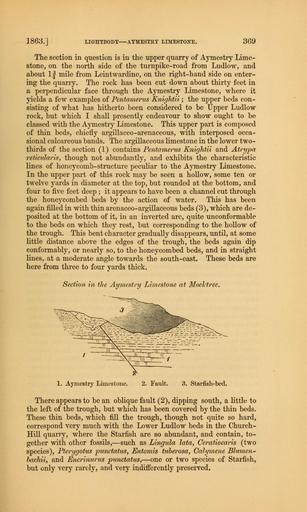MAKE A MEME
View Large Image

| View Original: | The_Quarterly_journal_of_the_Geological_Society_of_London_(12645811715).jpg (1225x2046) | |||
| Download: | Original | Medium | Small | Thumb |
| Courtesy of: | commons.wikimedia.org | More Like This | ||
| Keywords: The Quarterly journal of the Geological Society of London (12645811715).jpg 1863 LIGHTBODY AYMESTRY LIMESTONE 3G9 <br> The section in question is in the upper quarry of Aymestry Lime- <br> stone on the north side of the turnpike-road from Ludlow and <br> about 1 mile from Leintwardine on the right-hand side on enter- <br> ing the quarry The rock has been cut down about thirty feet in <br> a perpendicular face through the Aymestry Limestone where it <br> yields a few examples of Pentamerus Knightii ; the upper beds con- <br> sisting of what has hitherto been considered to be Upper Ludlow <br> rock but which I shall presently endeavour to show ought to be <br> classed with the Aymestry Limestone This upper part is composed <br> of thin beds chiefly argillaceo-arenaceous with interposed occa- <br> sional calcareous bands The argillaceous limestone in the lower two- <br> thirds of the section 1 contains Pentamerus Knightii and Atrypa <br> reticularis though not abundantly and exhibits the characteristic <br> lines of honeycomb -structure peculiar to the Aymestry Limestone <br> In the upper part of this rock may be seen a hollow some ten or <br> twelve yards in diameter at the top but rounded at the bottom and <br> four to five feet deep ; it appears to have been a channel cut through <br> the honeycombed beds by the action of water This has been <br> again filled in with thin arenaceo- argillaceous beds 3 which are de- <br> posited at the bottom of it in an inverted arc quite unconformable <br> to the beds on which they rest but corresponding to the hollow of <br> the trough This bent character gradually disappears until at some <br> little distance above the edges of the trough the beds again dip <br> conformably or nearly so to the honeycombed beds and in straight <br> lines at a moderate angle towards the south-east These beds are <br> here from three to four yards thick <br> Section in the Aymestry Limestone at Mocktree <br> 2 N <br> 1 Aymestry Limestone 2 Fault 3 Starfish-bed <br> There appears to be an oblique fault 2 dipping south a little to <br> the left of the trough but which has been covered by the thin beds <br> These thin beds which fill the trough though not quite so hard <br> correspond very much with the Lower Ludlow beds in the Church- <br> Hill quarry where the Starfish are so abundant and contain to- <br> gether with other fossils ” such as Lingula lata Ceratiocaris two <br> species Pterygotus punctatus Entomis tuberosa Calymene Blumen- <br> bachii and Encrinurus punctatus ” one or two species of Starfish <br> but only very rarely and very indifferently preserved 35328340 109632 51125 Page 369 Text v 19 http //www biodiversitylibrary org/page/35328340 1863 Geological Society of London NameFound Atrypa reticularis NameConfirmed Atrypa reticularis NameBankID 5482332 NameFound Calymene NameConfirmed Calymene EOLID 4322334 NameBankID 2875639 NameFound Ceratiocaris NameConfirmed Ceratiocaris EOLID 4291597 NameBankID 4108201 NameFound Encrinurus punctatus NameConfirmed Encrinurus punctatus NameBankID 6114830 NameFound Entomis tuberosa NameConfirmed Entomis tuberosa NameBankID 6525840 NameFound Lingula lata NameConfirmed Lingula lata NameBankID 7057770 NameFound Pentamerus NameConfirmed Pentamerus EOLID 3201214 NameBankID 4287886 NameFound Pterygotus punctatus Biodiversity Heritage Library The Quarterly journal of the Geological Society of London v 19 1863 Geology Periodicals Smithsonian Libraries bhl page 35328340 dc identifier http //biodiversitylibrary org/page/35328340 smithsonian libraries Information field Flickr posted date ISOdate 2014-02-20 Check categories 2015 August 26 CC-BY-2 0 BioDivLibrary https //flickr com/photos/61021753 N02/12645811715 2015-08-27 12 00 00 cc-by-2 0 PD-old-70-1923 The Quarterly journal of the Geological Society of London 1863 Photos uploaded from Flickr by Fæ using a script | ||||